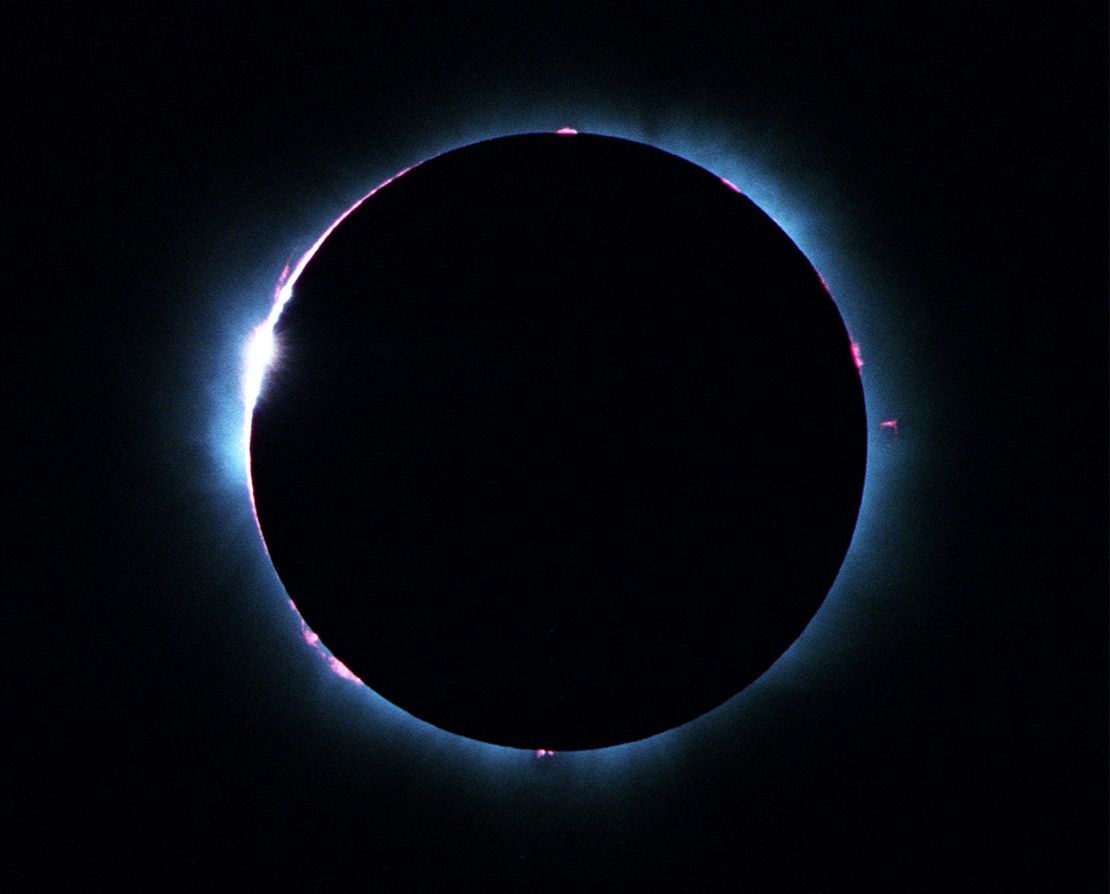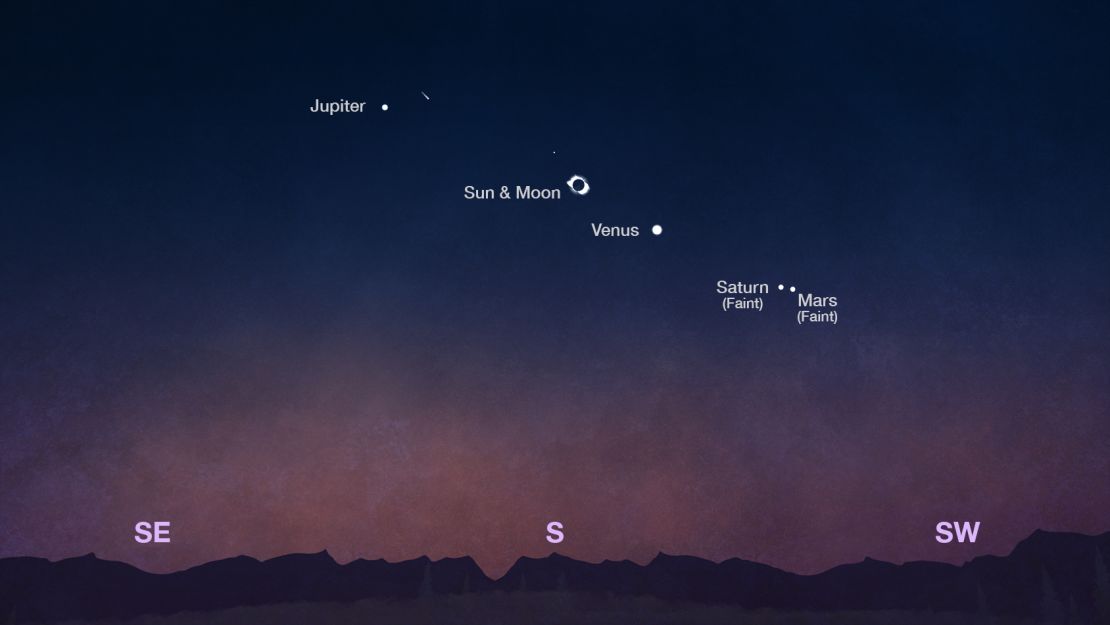Total solar eclipse: Where and when to watch and what to look out for

The day has finally arrived. After a nearly seven-year wait, it’s time for a total solar eclipse to create a celestial spectacle in the skies over the United States as well as parts of Mexico and Canada.
An estimated 32 million people across the US live within the path of totality, or locations where the moon will completely block the face of the sun from view for a few moments.
The eclipse will first appear over the South Pacific Ocean and begin its journey across North America. Mexico’s Pacific coast is the first point of totality on the path, expected at 11:07 a.m. PT (2:07 p.m. ET), and the eclipse is expected to end on the Atlantic coast of Newfoundland at 5:16 p.m. local time (3:46 p.m. ET). Check to see what the eclipse will look like and when it will appear over your area using our map.
Those squarely along the center line of the path will see an eclipse that lasts between 3 ½ and 4 minutes, according to NASA.
In the US, a total solar eclipse will be visible for those in Texas, Oklahoma, Arkansas, Missouri, Illinois, Kentucky, Indiana, Ohio, Pennsylvania, New York, Vermont, New Hampshire and Maine, although weather threatens to spoil the fun for some.
Only a few isolated clouds are expected in Vermont through Maine, as well as Missouri through southern Indiana, making for optimal eclipse viewing. However, much of Texas and the eastern Great Lakes may see less than ideal weather.
A partial solar eclipse, where the moon appears to take a crescent-shaped “bite” out of the sun, will be visible for those outside the path of totality.
Remember to grab a pair of certified eclipse glasses or a solar viewer to watch the skies safely; it isn’t safe to view any phase of an eclipse, except for when the moon completely block’s the sun’s light, without proper eye protection. And sunglasses, or multiple pairs of sunglasses, won’t cut it. The biggest risk of looking at the sun without the dark filter of eclipse glasses or solar viewers is permanent eye damage known as solar retinopathy. This condition can improve or worsen over time, but it can’t be treated.
Worried that your eclipse glasses could be counterfeit? There’s an easy way to test for that problem. And if your eclipse glasses aren’t safe, or you’re worried about children removing their glasses, make an easy pinhole projector to join in the eclipse fanfare.
Special eclipse moments
While totality is considered to be the most exciting part of a total solar eclipse, there are other special phases to watch for before the big moment arrives.
Apart from the weeks and months of anticipation leading up to the eclipse, the longest phase of the event is the partial eclipse, as the moon slowly moves over the sun. This phase can last from 70 to 80 minutes.
But a great cue for spectators will be when the skies start to darken and turn an eerie gray color, about 15 to 20 minutes before totality.
Then, several phases happen in quick succession just before the sun’s light completely disappears from view.

Look for drops of sunlight to form around the moon, known as Baily’s beads, as sunlight streams over the craters and valleys of the lunar surface. After about 30 seconds to a minute, some of those drops will appear to merge together, creating a glistening “diamond ring” effect. After about another minute, the moon will seem to move completely in front of the sun, and only a white halo of light will be visible as totality begins.
The luminous glow belongs to the sun’s corona, or hot outer atmosphere, and its faint light is only visible when the sun’s ultrabright surface is blocked. Astronomers are eager to study the corona with a number of experiments, including high-altitude research planes, to better understand fine structures within it and why the corona is millions of degrees hotter than the surface of the sun.
While totality is the main event, a few dots of light may also be visible in the sky near the eclipse, belonging to Jupiter, Venus, Mars and the faint light from Saturn.

The horned “devil comet,” or Comet 12P/Pons-Brooks, will likely be too faint to be seen without a telescope or binoculars — but the eclipse is the key moment to watch Monday anyway, according to astronomers.
During the ephemeral darkness of the total eclipse, some daytime animals may fall silent, while nocturnal creatures such as crickets may begin to chirp and stir. Scientists are eager to study why animals behave unusually during the brief moments of eclipses, and the public is invited to participate in some of the research taking place Monday.
And expect the local temperature to drop briefly during those few moments of totality.
A diamond ring effect will be visible on the other side of the moon as totality ends, followed by Baily’s beads, and then a partial eclipse as the temporary alignment of the sun, moon and Earth, known as syzygy, comes to an end.
When will the next eclipse occur?
After the total solar eclipse ends, it’s a bit of a wait for the next such celestial sightings in the United States.
Those living in Alaska will catch a glimpse of a total solar eclipse on March 30, 2033, and a partial solar eclipse will shine over most of the US during that event.
A total solar eclipse won’t be visible again from the contiguous US until August 22, 2044, but totality will only occur over North Dakota and Montana, plus northern Canada.
However, the next total solar eclipse with a coast-to-coast path spanning the Lower 48 states will occur on August 12, 2045. The path of totality will arc over California, Nevada, Utah, Colorado, Kansas, Oklahoma, Arkansas, Mississippi, Alabama and Florida, with a partial eclipse visible across other states.
Don’t miss out on upcoming eclipse and space stories! Follow the Astronomy topic to see the latest stories in your personalized feed with your free account.
The post Total solar eclipse: Where and when to watch and what to look out for appeared first on Egypt Independent.
What's Your Reaction?
 Like
0
Like
0
 Dislike
0
Dislike
0
 Love
0
Love
0
 Funny
0
Funny
0
 Angry
0
Angry
0
 Sad
0
Sad
0
 Wow
0
Wow
0




















































